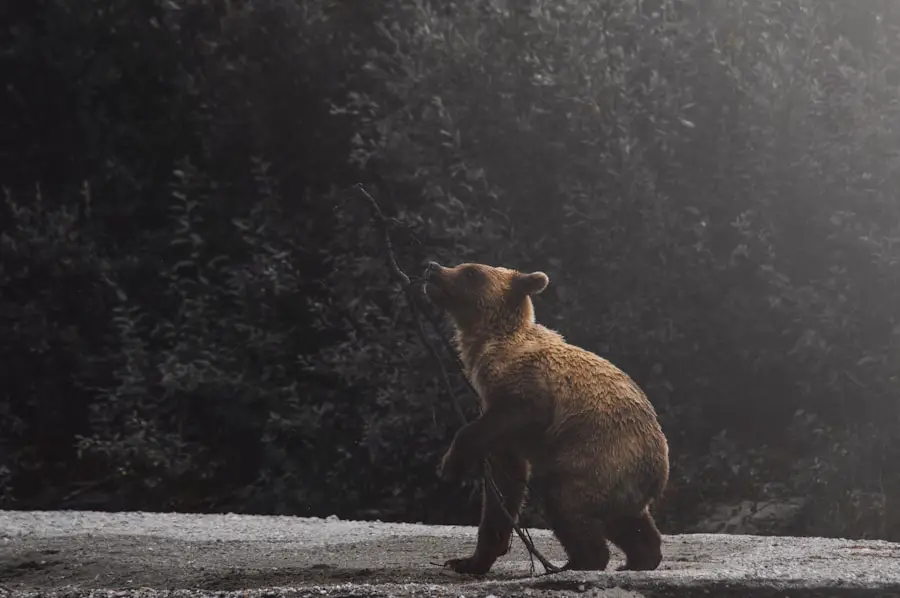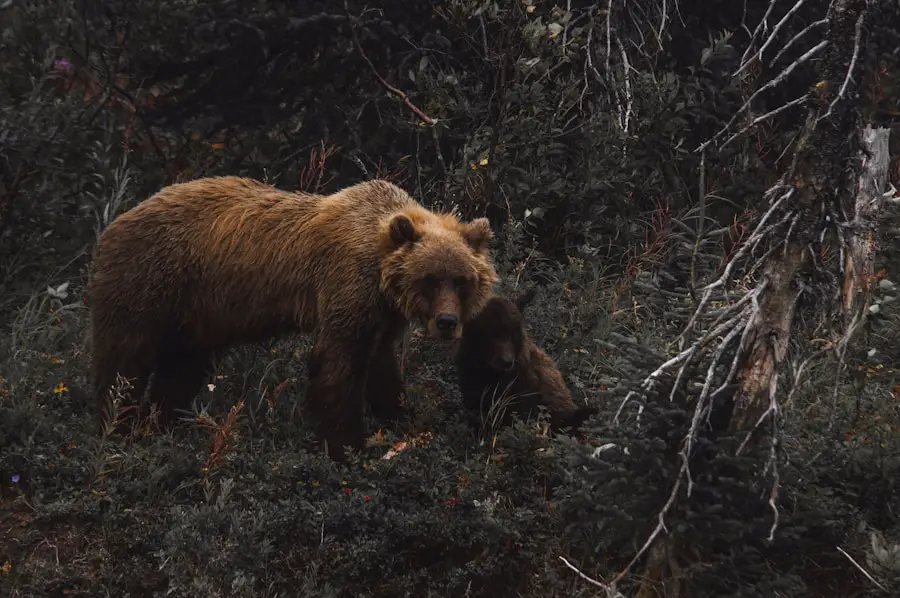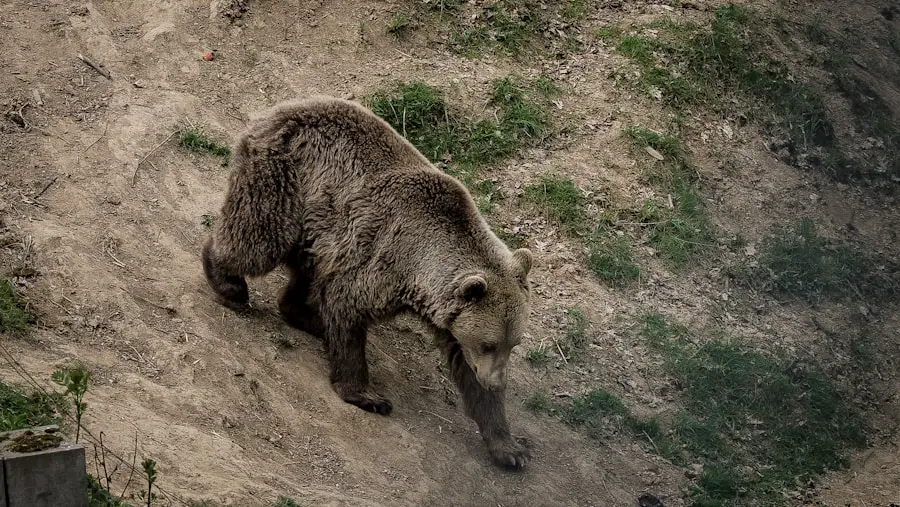Bears are complex creatures with behaviors that can be both fascinating and intimidating. Understanding their behavior is crucial for anyone venturing into bear country. Bears are generally solitary animals, with the exception of mothers with cubs or during mating season.
They exhibit a range of behaviors that can indicate their mood or intentions. For instance, a bear that is foraging for food may appear calm and focused, while a bear that feels threatened might stand on its hind legs to get a better view or sniff the air to assess the situation. This behavior is often misinterpreted as aggression, but it is primarily a means of gathering information.
Bears are also highly intelligent and adaptable animals. They have excellent memories and can remember the locations of food sources for years. This adaptability means that they can thrive in various environments, from dense forests to mountainous regions.
Their foraging habits change with the seasons; in spring, they may dig for roots and eat emerging vegetation, while in summer, they often seek out berries and insects. Understanding these seasonal behaviors can help hikers anticipate where bears might be found and how to avoid encounters.
Key Takeaways
- Bears are generally shy and avoid humans, but can become aggressive if they feel threatened or are defending their food or cubs.
- Proper food storage is essential to prevent attracting bears to your campsite, including using bear-proof containers or hanging food in a tree away from your sleeping area.
- Making noise while hiking can help alert bears to your presence and prevent surprising them, such as talking loudly or clapping hands in bear country.
- Bear spray is an effective deterrent when encountering a bear at close range, and it should be carried and easily accessible while hiking in bear country.
- It’s important to avoid mother bears with cubs, as they can be especially protective and aggressive if they feel their cubs are threatened.
Proper Food Storage
One of the most critical aspects of safely enjoying the outdoors in bear territory is proper food storage. Bears have an extraordinary sense of smell, which can be up to seven times more acute than that of a bloodhound. This keen sense allows them to detect food from miles away, making it essential for campers and hikers to store food securely.
The best practice is to use bear-proof containers or canisters specifically designed to withstand a bear’s attempts to access food. These containers are often made from durable materials that bears cannot easily break into, providing an effective barrier between your food and curious bears. In addition to using bear-proof containers, it is vital to follow local guidelines regarding food storage.
In many national parks and wilderness areas, regulations require that food be stored at least 100 yards away from sleeping areas and hung from trees if bear-proof containers are not available. The method of hanging food involves suspending it at least 10 feet off the ground and 4 feet away from the trunk of the tree to prevent bears from climbing up and reaching it. This practice not only protects your food but also minimizes the chances of attracting bears to your campsite.
Making Noise While Hiking

When hiking in bear country, making noise is an effective strategy to reduce the likelihood of an encounter. Bears are generally shy animals that prefer to avoid humans whenever possible. By making noise, you alert bears to your presence, giving them the opportunity to move away before you come too close.
Simple actions like talking loudly, clapping your hands, or using bear bells can be effective in this regard. The sound carries through the forest, allowing bears to hear you from a distance. However, it is essential to strike a balance when making noise.
While you want to be loud enough to alert bears, excessive noise can also disturb other wildlife and detract from the natural experience of hiking. A good rule of thumb is to maintain a moderate volume while engaging in conversation with your hiking companions or singing songs. This approach not only keeps you safe but also enhances the enjoyment of your hike by fostering camaraderie among your group.
Using Bear Spray
| Year | Number of Bear Spray Uses | Number of Successful Deterrences | Number of Injuries Prevented |
|---|---|---|---|
| 2017 | 50 | 48 | 20 |
| 2018 | 65 | 60 | 25 |
| 2019 | 72 | 68 | 30 |
| 2020 | 80 | 75 | 35 |
Bear spray is an essential tool for anyone hiking in areas inhabited by bears. This deterrent is a type of pepper spray specifically formulated to stop aggressive bear behavior effectively. When used correctly, bear spray can deter a bear from approaching or attacking by causing temporary discomfort and disorientation.
It is crucial to carry bear spray in an easily accessible location, such as a holster on your hip or attached to your backpack, so that you can quickly deploy it if necessary. Understanding how to use bear spray effectively is just as important as having it on hand. The general recommendation is to aim for the bear’s face when spraying, as this targets its sensitive eyes and nose.
It is also advisable to spray in short bursts rather than a continuous stream, as this conserves the spray and allows for better control over the direction of the mist. Additionally, practicing with an inert canister can help familiarize you with the mechanics of using bear spray under pressure, ensuring that you are prepared should an encounter occur.
Avoiding Mother Bears with Cubs
One of the most critical aspects of bear safety is understanding the dynamics between mother bears and their cubs. Mother bears are fiercely protective of their young and will go to great lengths to defend them if they perceive a threat. It is essential for hikers to recognize that encountering a mother bear with cubs can be particularly dangerous.
If you see cubs alone, it is crucial not to approach them; the mother is likely nearby and will respond aggressively if she feels her cubs are in danger. To minimize the risk of encountering a mother bear with cubs, hikers should educate themselves about bear breeding seasons and cub development stages. In many regions, cubs are born in late winter and remain with their mothers for about 1.5 years.
During this time, mothers will often lead their cubs through various habitats as they learn essential survival skills. Being aware of these patterns can help hikers choose safer routes and avoid areas where mothers may be raising their young.
Recognizing Bear Signs

Recognizing signs of bear activity is vital for staying safe while hiking in bear country. Bears leave various indicators of their presence, including tracks, scat, claw marks on trees, and overturned rocks or logs where they have been foraging for insects or roots. Familiarizing yourself with these signs can help you gauge whether you are entering an area frequented by bears and adjust your plans accordingly.
For instance, bear tracks can vary significantly depending on the species; black bear tracks are typically smaller and more rounded than those of grizzly bears, which are larger and have distinct claw marks visible in their prints. Scat can also provide valuable information; fresh scat may contain berries or fur, indicating recent feeding activity nearby. By paying attention to these signs, hikers can make informed decisions about their surroundings and take necessary precautions if they suspect they are in an area with active bear populations.
Hiking in Groups
Hiking in groups is one of the most effective strategies for reducing the risk of bear encounters. Bears are less likely to approach larger groups due to the increased noise and movement associated with multiple people. When hiking in a group, it is essential to stay close together rather than spreading out along the trail.
This collective presence not only deters bears but also enhances safety by ensuring that everyone can look out for one another. In addition to group size, maintaining communication within the group is crucial. Establishing a system for making noise—such as designating a person responsible for leading conversations or singing—can help ensure that everyone remains aware of their surroundings while still enjoying each other’s company.
Furthermore, groups should consider carrying multiple bear sprays and ensuring that everyone knows how to use them effectively in case of an emergency.
Knowing What to Do if You Encounter a Bear
Despite taking precautions, there may still be instances where hikers encounter bears unexpectedly. Knowing how to react in such situations can significantly impact safety outcomes. If you come across a bear at a distance, it is best to remain calm and avoid sudden movements that could startle the animal.
Instead, slowly back away while keeping your eyes on the bear without making direct eye contact, which could be perceived as a challenge. If a bear approaches you aggressively—such as charging or making threatening gestures—your response will depend on whether it is a black bear or a grizzly bear. In general, if you encounter a black bear, it is advisable to stand your ground and make yourself appear larger by raising your arms or backpack above your head while shouting firmly at the bear.
Conversely, if confronted by a grizzly bear, playing dead may be more effective; lie flat on your stomach with your hands clasped behind your neck until the bear leaves the area. Understanding these behaviors and responses can significantly enhance safety while enjoying nature in areas inhabited by bears. By respecting these magnificent creatures and taking appropriate precautions, hikers can minimize risks and foster a safer outdoor experience for themselves and wildlife alike.
When hiking in bear country, it is important to take precautions to avoid any potential encounters. One helpful article to read is “Best Time to Visit Amalfi Coast: A Seasonal Guide”, which provides tips on when to visit this beautiful destination in Italy. Just as it is important to plan your trip to the Amalfi Coast at the right time, it is crucial to plan your hike in bear country with safety in mind. Remember to make noise, travel in groups, and carry bear spray to reduce the risk of a bear encounter.
FAQs
What should I do if I encounter a bear while hiking?
If you encounter a bear while hiking, it’s important to remain calm and avoid sudden movements. Back away slowly while facing the bear and speak in a calm, firm voice. Do not run or make sudden movements, as this may provoke the bear.
How can I prevent bear encounters while hiking?
To prevent bear encounters while hiking, make noise while on the trail to alert bears of your presence. Keep food and scented items in bear-proof containers or hang them in a bear bag away from your campsite. Be aware of your surroundings and stay alert for signs of bear activity.
What should I do if a bear approaches my campsite?
If a bear approaches your campsite, make loud noises to scare it away. Use bear spray if necessary and do not attempt to approach or feed the bear. Keep all food and scented items secured and away from the bear.
What are some signs of bear activity in the area?
Signs of bear activity in the area may include tracks, scat, overturned rocks or logs, and claw marks on trees. Be aware of these signs and take precautions to avoid bear encounters in areas with known bear activity.
What should I do if a bear charges at me while hiking?
If a bear charges at you while hiking, stand your ground and use bear spray if you have it. Do not run, as this may trigger the bear’s predatory instincts. If the bear makes contact, play dead and protect your vital organs until the bear leaves the area.
